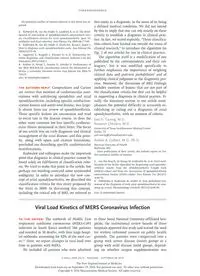
2016 Viral Load Kinetics of MERS Coronavirus Infection PDF
Preview 2016 Viral Load Kinetics of MERS Coronavirus Infection
Correspondence n engl j med 375;13 nejm.org September 29, 2016 No potential conflict of interest relevant to this letter was re- ported. 1. Rudwaleit M, van der Heijde D, Landewé R, et al. The devel- opment of Assessment of SpondyloArthritis international Soci- ety classification criteria for axial spondyloarthritis (part II): validation and final selection. Ann Rheum Dis 2009; 68: 777-83. 2. Rudwaleit M, van der Heijde D, Khan MA, Braun J, Sieper J. How to diagnose axial spondyloarthritis early. Ann Rheum Dis 2004; 63: 535-43. 3. Aggarwal R, Ringold S, Khanna D, et al. Distinctions be- tween diagnostic and classification criteria? Arthritis Care Res (Hoboken) 2015; 67: 891-7. 4. Radner H, Neogi T, Smolen JS, Aletaha D. Performance of the 2010 ACR/EULAR classification criteria for rheumatoid ar- thritis: a systematic literature review. Ann Rheum Dis 2014; 73: 114-23. DOI: 10.1056/NEJMc1609622 The authors reply: Campochiaro and Caruso are correct that mention of cardiovascular asso- ciations with ankylosing spondylitis and axial spondyloarthritis, including specific conduction- system lesions and aortic-root lesions, was large- ly absent from our review of spondyloarthritis. These specific lesions are uncommon and tend to occur late in the disease course, as does the other more common but less specific cardiovas- cular illness mentioned in their letter. The focus of our article was on early diagnosis and clinical management of the axial disease, and this prior- ity, along with space and citation limitations, precluded our describing specific cardiovascular manifestations. Rudwaleit and colleagues make the important point that diagnosis in clinical practice cannot be based solely on fulfillment of classification crite- ria. We tried to make this point in the article, but perhaps our wording conveyed some unintended ambiguity. In order to introduce the new con- cept of axial spondyloarthritis, we described the classification criteria for this entity proposed by the ASAS in 2009. In discussing this concept, including the critical role of MRI, we referred to this entity as a diagnosis, in the sense of its being a defined medical condition. We did not intend by this to imply that one can rely strictly on these criteria to establish a diagnosis in clinical prac- tice. In fact, we stated explicitly, “These classifica- tion criteria have limited use outside the arena of clinical research,” to introduce the algorithm (in Fig. 2 of our article) for use in clinical practice. The algorithm itself is a modification of one published by the correspondents and their col- leagues,1 but it was modified specifically to further emphasize the importance of weighing clinical data and post-test probabilities2 and of applying clinical judgment to the diagnostic pro- cess. Moreover, the discussion of MRI findings includes mention of lesions that are not part of the classification criteria but that can be helpful in supporting a diagnosis in clinical practice. Fi- nally, the Summary section in our article reem- phasizes the potential difficulty in accurately es- tablishing or ruling out a diagnosis of axial spondyloarthritis, with no mention of criteria. Joel D. Taurog, M.D. Avneesh Chhabra, M.D. University of Texas Southwestern Medical Center Dallas, TX joel .
